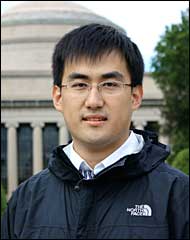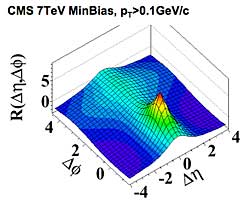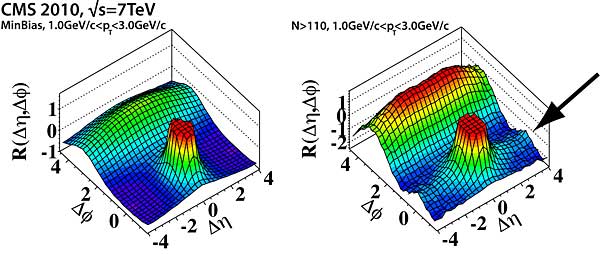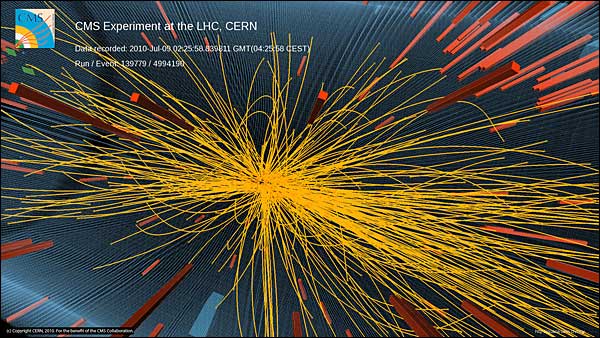Observation of Long-Range Near-Side Angular Correlations in Proton-Proton Collisions
October 5, 2010

Wei Li
On September 21st, the CMS Collaboration hosted a special seminar at CERN to announce a paper entitled "Observation of Long-Range Near-Side Angular Correlations in Proton-Proton Collisions" that details signs of a new phenomenon in proton-proton collisions. The new finding describes a novel correlation that particles coming out of the collision are aligned in their azimuthal angle over a large pseudorapidity region, a "ridge"-like structure that is absent in minimum bias events but emerges as particle multiplicity reaches very high value. This phenomenon has not been observed before in proton-proton (pp) collisions but resembles similar effect (e.g., hydrodynamic flow) following collisions of nuclei such as copper and gold ions at the Relativistic Heavy Ion Collider (RHIC). Due to this, there is broad interest in this phenomenon, particularly in the heavy ion physics community.
Display of a very high multiplicity pp collision in CMS is illustrated in Fig. 1, with more than 110 charged particles produced inside the CMS tracker. Such events would be difficult for searches like Higgs, SUSY etc. The reason of studying very high multiplicity hadron processes is many-sided. High multiplicity events are rare in nature and dominated by significant QCD activities. Potential new phenomena of QCD could be revealed, and thus warrant detailed investigations. Furthermore, with increasing collision rate at the highest center of mass energy pp collisions at LHC, the tail of the multiplicity distribution can reach values as high as more than 50 particles per unit of pseudorapidity. Such high particle density begins to approach that in semi-peripheral collisions of relativistic nuclear collisions such as Cu+Cu at RHIC. Therefore, it is natural to search for the possible signatures of high-density and hot QCD matter in high multiplicity pp environment, which is believed to form in relativistic heavy ion collisions. This is the original motivation of the analysis in CMS.
Hunting for new physics in high multiplicity pp processes is a demanding task. Collisions releasing huge amount of particles only happen with a fairly low probability (~ 10^{-5}). In CMS, two colliding bunches of protons cross each other at a high rate up to several MHz, out of which only a couple of hundred events per second can be recorded by the CMS data acquisition system. A dedicated online high multiplicity trigger was deployed to capture the highest multiplicity collisions at a rate of 1-2Hz. The key challenge was to select collisions with large number of particles originating from a single primary vertex. An algorithm of simply counting number of fired channels in the detector will be susceptible to multiple "pileup" interactions in the same bunch crossing, especially during high proton beam intensity operation at LHC. Owing to the powerful High-Level Trigger farm in CMS, trajectories of charged particles can be promptly reconstructed using three layers of silicon pixel detector with high resolution in momentum (a few %) and back pointing position (~100 microns) such that all primary interacting points can be precisely located in each bunch crossing. About 350,000 events with average multiplicity 7-8 times that of minimum bias collisions were collected for the analysis.
Studies of multi-particle correlation have proven to be a powerful tool in tackling many aspects of particle production in high-energy hadronic and nucleus collisions. In heavy ion collisions, properties of particle correlations were found to be strongly modified in the presence of a hot and dense QCD matter. A characteristic transverse momentum ($p_T$) inclusive two-particle correlation function over large phase space in η and φ for minimum bias pp collisions is shown in Fig. 2 measured by CMS at 7TeV. The complex structure is dominated mainly by three components: a narrow peak at (Δη, Δφ) ~ (0,0) from higher $p_T$ clusters (e.g., hard processes like jets); an approximately Gaussian ridge at Δη ~ 0 extending over the whole range of Δφ, which arises from the decay of clusters with lower $p_T$ (e.g., soft QCD string fragmentation); and also a ridge at Δφ ~ π spread over abroad range in Δη, interpreted as due to back-to-back jets or, more generally, momentum conservation.

Moving onto high multiplicity events in pp collisions, the $p_T$ integrated two-particle correlation function shows a similar structure to those for minimum bias events (Fig. 2, on the left). Besides the more pronounced away-side ridge due to the presence of several jets in this high multiplicity environment, nothing appears to be unexpected. A surprising feature arises if one not only raises the event multiplicity but also varies the transverse momentum. Requiring both particles to be in a moderate $p_T$ range (1-3GeV/c) gives the result shown in Fig. 2 on the right, a striking "ridge"-like structure emerges at Δφ \approx 0$ extending to $|Δη|$ of at least 4 units. This novel feature of the data has never been seen in two-particle correlation functions in pp collisions. After the main results were complete, the last few months have been devoted to the hard work of performing various cross-checks to kill the signal in order to exclude any possible mistake. The efforts, however, were not yet successful.

Although it is still too early to draw any definitive conclusion on the physical original of the observation, the fact that particles are correlated over such a long-range in pseudorapidity indicates that the phenomena must have been established shortly after the collisions, and thus sensitive to the initial conditions of the proton-proton collisions. A set of further studies is being proposed by a rapidly-expanding group of interested collaborators in CMS. Of particular importance are the large acceptance and calorimetric coverage which will allow a quantitative study of the correlations in the pi0 channel, while higher order correlation measurements like jet-hadron and three-particle correlations will be able to discriminate between different hypotheses for the origin of the correlations, as well as its potential connection to various phenomena established in heavy ion physics at RHIC. With this observation, we are exploring an unknown territory of studying QCD under extreme condition in a small collision system. It seems clear that exciting new opportunities for discovering more surprises are awaiting us in the near future.
2010-2050 | INT/EXT | Newsroom










